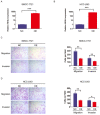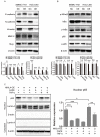NKILA, a prognostic indicator, inhibits tumor metastasis by suppressing NF-κB/Slug mediated epithelial-mesenchymal transition in hepatocellular carcinoma
- PMID: 32015685
- PMCID: PMC6990899
- DOI: 10.7150/ijbs.39582
NKILA, a prognostic indicator, inhibits tumor metastasis by suppressing NF-κB/Slug mediated epithelial-mesenchymal transition in hepatocellular carcinoma
Abstract
The metastasis of hepatocellular carcinoma (HCC) is one of the major obstacles hindering its therapeutic efficacy, leading to low surgical resection rate, high mortality and poor prognosis. Accumulating evidence has shown that both long noncoding RNA (lncRNA) and NF-κB play vital roles in the regulation of cancer metastasis. However, the clinical significance and biological function of NKILA (NF-κB interacting lncRNA) and its interaction with NF-κB in HCC remain unknown. In this study, we demonstrated that NKILA was down-regulated in HCC tissues and cell lines, and decreased NKILA expression was significantly associated with larger tumor size and positive vascular invasion in HCC patients. NKILA reduction was an independent risk factor of HCC patients' poor prognosis, and the 5-year overall survival (OS) rates of patients with low and high NKILA expression were 15.6% and 60.0%, respectively. Moreover, NKILA inhibits migration and invasion of HCC cells both in vitro and in vivo. Mechanistically, NKILA prevents Slug/epithelial to mesenchymal transition (EMT) pathway via suppressing phosphorylation of IκBα, p65 nuclear translocation and NF-κB activation. In conclusion, these results indicate that NKILA might serve as an effective prognostic biomarker and a promising therapeutic target against HCC metastasis.
Keywords: Epithelial to mesenchymal transition; Hepatocellular carcinoma; LncRNA-NKILA; Metastasis; NF-κB.
© The author(s).
Conflict of interest statement
Competing Interests: The authors have declared that no competing interest exists.
Figures





Similar articles
-
Long non-coding RNA NKILA inhibits migration and invasion of non-small cell lung cancer via NF-κB/Snail pathway.J Exp Clin Cancer Res. 2017 Apr 17;36(1):54. doi: 10.1186/s13046-017-0518-0. J Exp Clin Cancer Res. 2017. PMID: 28412955 Free PMC article.
-
Long non-coding RNA NKILA inhibits migration and invasion of tongue squamous cell carcinoma cells via suppressing epithelial-mesenchymal transition.Oncotarget. 2016 Sep 20;7(38):62520-62532. doi: 10.18632/oncotarget.11528. Oncotarget. 2016. PMID: 27613832 Free PMC article.
-
Long noncoding RNA NKILA enhances the anti-cancer effects of baicalein in hepatocellular carcinoma via the regulation of NF-κB signaling.Chem Biol Interact. 2018 Apr 1;285:48-58. doi: 10.1016/j.cbi.2018.02.027. Epub 2018 Feb 23. Chem Biol Interact. 2018. PMID: 29481769
-
Long non-coding RNAs regulated NF-κB signaling in cancer metastasis: Micromanaging by not so small non-coding RNAs.Semin Cancer Biol. 2022 Oct;85:155-163. doi: 10.1016/j.semcancer.2021.07.015. Epub 2021 Jul 24. Semin Cancer Biol. 2022. PMID: 34314819 Review.
-
LncRNA influence sequential steps of hepatocellular carcinoma metastasis.Biomed Pharmacother. 2021 Apr;136:111224. doi: 10.1016/j.biopha.2021.111224. Epub 2021 Jan 12. Biomed Pharmacother. 2021. PMID: 33450489 Review.
Cited by
-
Impact of immunosuppressants on tumor pulmonary metastasis: new insight into transplantation for hepatocellular carcinoma.Cancer Biol Med. 2024 Dec 24;21(11):1033-49. doi: 10.20892/j.issn.2095-3941.2024.0267. Cancer Biol Med. 2024. PMID: 39718153 Free PMC article. Review.
-
Clinicopathological and prognostic value of long noncoding RNA SNHG7 in cancers: a meta-analysis and bioinformatics.Aging (Albany NY). 2021 Oct 29;13(20):23796-23809. doi: 10.18632/aging.203650. Epub 2021 Oct 29. Aging (Albany NY). 2021. PMID: 34714775 Free PMC article.
-
SAIF plays anti-angiogenesis via blocking VEGF-VEGFR2-ERK signal in tumor treatment.Heliyon. 2023 Jul 14;9(7):e18240. doi: 10.1016/j.heliyon.2023.e18240. eCollection 2023 Jul. Heliyon. 2023. PMID: 37539189 Free PMC article.
-
The Crosstalk Between Regulatory Non-Coding RNAs and Nuclear Factor Kappa B in Hepatocellular Carcinoma.Front Oncol. 2021 Nov 5;11:775250. doi: 10.3389/fonc.2021.775250. eCollection 2021. Front Oncol. 2021. PMID: 34804980 Free PMC article. Review.
-
LncRNA NKILA inhibits HBV replication by repressing NF-κB signalling activation.Virol Sin. 2024 Feb;39(1):44-55. doi: 10.1016/j.virs.2023.10.002. Epub 2023 Oct 11. Virol Sin. 2024. PMID: 37832719 Free PMC article.
References
-
- Torre LA, Bray F, Siegel RL, Ferlay J, Lortet-Tieulent J, Jemal A. Global cancer statistics, 2012. CA: a cancer journal for clinicians. 2015;65:87–108. - PubMed
-
- Chen W, Zheng R, Baade PD, Zhang S, Zeng H, Bray F. et al. Cancer statistics in China, 2015. CA: a cancer journal for clinicians. 2016;66:115–32. - PubMed
-
- Natsuizaka M, Omura T, Akaike T, Kuwata Y, Yamazaki K, Sato T. et al. Clinical features of hepatocellular carcinoma with extrahepatic metastases. Journal of gastroenterology and hepatology. 2005;20:1781–7. - PubMed
Publication types
MeSH terms
Substances
LinkOut - more resources
Full Text Sources
Medical
Research Materials

